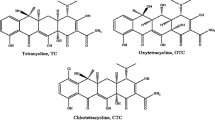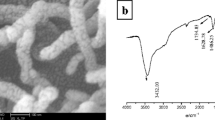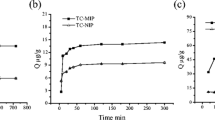Abstract
This study proposes new molecularly imprinted solid-phase microextraction (MIP-SPME) coatings based on a sandwich method for the extraction of 2,4-dichlorophenoxyacetic acid (2,4-D) from milk samples. MIP-SPME coatings were prepared by sandwich surface polymerization, using 2,4-dichlorophenoxyacetic acid (2,4-D) as the template, 4-vinylpyridine as the functional monomer and PTFE membrane as supporting material. MIP-SPME coatings were characterized by Fourier transform infrared spectroscopy, scanning electron microscopy, Brunner Emmet Teller measurements and adsorption experiments. The adsorption capacities of nonimprinted polymer solid-phase microextraction and MIP-SPME coatings were 41.8 mg/g and 31.8 mg/g, respectively. Regeneration adsorption was achieved in 137 runs (relative standard deviation, RSD ≤ 6.35%) with an indication of high stability and reusability. The parameters, such as loading solvent, time and washing and elution solvents were optimized and found to be methanol–water (1/9, v/v), 1 h, water and acetonitrile–methanol (1/9, v/v), respectively. Under the optimized conditions, the developed SPME method was successfully applied for the selective extraction and determination of 2,4-D in milk samples coupled with HPLC, with a recovery of 88.8–96.6% (RSD ≤ 5.1%). The limits of determination and the limits of quantitation were found to be 0.03 and 0.1 mg L−1, respectively.






Similar content being viewed by others
Data availability
The raw data required to reproduce these findings are available to download from the website of European Polymer Journal in the form of supplementary information.
References
An Q, Huang T, Shi F (2018) Covalent layer-by-layer films: chemistry, design, and multidisciplinary applications. Chem Soc Rev 47:5061–5098. https://doi.org/10.1039/c7cs00406k
Arivazhagan M, Meenakshi R (2011) Quantum chemical studies on structure of 1–3-dibromo-5-chlorobenzene. Spectrochim Acta: Part A Mol Biomol Spectrosc 82:316–326. https://doi.org/10.1016/j.saa.2011.07.055
Arthur CL, Pawliszyn J (1990) Solid phase microextraction with thermal desorption using fused silica optical fibers. Anal Chem 62:2145–2148. https://doi.org/10.1021/ac00218a019
Aya GA, Yang JC, Hong SW, Park JY (2019) Replicated pattern formation and recognition properties of 2,4-dichlorophenoxyacetic acid-imprinted polymers using colloidal silica array molds. Polymers (basel) 11:1332. https://doi.org/10.3390/polym11081332
Bahari D, Babamiri B, Salimi A (2020) An eco-friendly MIP-solid surface fluorescence immunosensor for detection of CA 19–9 tumor marker using Ni nanocluster as an emitter labels. J Iran Chem Soc 17:2283–2291. https://doi.org/10.1007/s13738-020-01924-z
Beltran A, Marcé RM, Cormack PAG, Borrull F (2010) Synthetic approaches to parabens molecularly imprinted polymers and their applications to the solid-phase extraction of river water samples. Anal Chim Acta 677:72–78. https://doi.org/10.1016/j.aca.2010.07.021
Chen L, Muhammad T, Yakup B, Piletsky SA (2017) New immobilisation protocol for the template used in solid-phase synthesis of MIP nanoparticles. Appl Surf Sci 406:115–121. https://doi.org/10.1016/j.apsusc.2017.02.105
Dong C, Shi H, Han Y et al (2021) Molecularly imprinted polymers by the surface imprinting technique. Eur Polym J 145:110231. https://doi.org/10.1016/j.eurpolymj.2020.110231
Espina-Benitez M, Araujo L, Prieto A et al (2017) Development of a new microextraction fiber combined to on-line sample stacking capillary electrophoresis UV detection for acidic drugs determination in realwater samples. Int J Environ Res Public Health 14:1–16. https://doi.org/10.3390/ijerph14070739
Hassan MM, Zareef M, Jiao T et al (2021) Signal optimized rough silver nanoparticle for rapid SERS sensing of pesticide residues in tea. Food Chem. https://doi.org/10.1016/j.foodchem.2020.127796
Haupt K, Dzgoev A, Mosbach K (1998) Assay system for the herbicide 2,4-dichlorophenoxyacetic acid using a molecularly imprinted polymer as an artificial recognition element. Anal Chem 70:628–631. https://doi.org/10.1021/ac9711549
He S, Zhang L, Bai S et al (2021) Advances of molecularly imprinted polymers (MIP) and the application in drug delivery. Eur Polym J 143:110179. https://doi.org/10.1016/j.eurpolymj.2020.110179
Heydari R, Feyzianpour R (2021) Determination of 2,4-dichlorophenoxyacetic acid in water and edible seeds samples using salt-assisted liquid-liquid extraction coupled with high-performance liquid chromatography. Food Anal Methods 14:561–567. https://doi.org/10.1007/s12161-020-01903-3
Hua MZ, Feng S, Wang S, Lu X (2018) Rapid detection and quantification of 2,4-dichlorophenoxyacetic acid in milk using molecularly imprinted polymers–surface-enhanced Raman spectroscopy. Food Chem 258:254–259. https://doi.org/10.1016/j.foodchem.2018.03.075
Ji Z, Yu Y, Jin Q et al (2019) Determination of naturally occurring thyreostats in bovine milk by high performance liquid chromatography combined with fluorescence detection. Microchem J 145:892–898. https://doi.org/10.1016/j.microc.2018.11.052
Karlsson JG, Andersson LI, Nicholls IA (2001) Probing the molecular basis for ligand-selective recognition in molecularly imprinted polymers selective for the local anaesthetic bupivacaine. Anal Chim Acta 435:57–64. https://doi.org/10.1016/S0003-2670(00)01182-X
Li X, Lin M, Zhang H et al (2022) N-terminal epitope surface imprinted particles for high selective cytochrome c recognition prepared by reversible addition- fragmentation chain transfer strategy. Chem Pap. https://doi.org/10.1007/s11696-022-02134-y
Liu Y, He Y, Jin Y et al (2014) Preparation of monodispersed macroporous core-shell molecularly imprinted particles and their application in the determination of 2,4-dichlorophenoxyacetic acid. J Chromatogr A 1323:11–17. https://doi.org/10.1016/j.chroma.2013.11.002
Marquardt R, Luce E (1951) Determination of small amounts of 2, 4: dichloro- phenoxyacetic acid in milk. Anal Chem 23:1484–1486. https://doi.org/10.1021/ac60058a033
Mirnaghi FS, Pawliszyn J (2012) Development of coatings for automated 96-blade solid phase microextraction-liquid chromatography-tandem mass spectrometry system, capable of extracting a wide polarity range of analytes from biological fluids. J Chromatogr A 1261:91–98. https://doi.org/10.1016/j.chroma.2012.07.012
Pandey H, Khare P, Singh S, Singh SP (2020) Carbon nanomaterials integrated molecularly imprinted polymers for biological sample analysis: a critical review. Mater Chem Phys 239:121966. https://doi.org/10.1016/j.matchemphys.2019.121966
Peng MM, Han YQ, Xia H et al (2018) Rapid and sensitive detection of the phenoxy acid herbicides in environmental water samples by magnetic solid-phase extraction combined with liquid chromatography–tandem mass spectrometry. J Sep Sci 41:2221–2228. https://doi.org/10.1002/jssc.201701325
Peng S, Huang X, Huang Y et al (2022) Novel solid-phase microextraction fiber coatings: a review. J Sep Sci 45:282–304. https://doi.org/10.1002/jssc.202100634
Sheng L, Jin Y, He Y et al (2017) Well-defined magnetic surface imprinted nanoparticles for selective enrichment of 2,4-dichlorophenoxyacetic acid in real samples. Talanta 174:725–732. https://doi.org/10.1016/j.talanta.2017.07.002
Singh M, Singh S, Singh SP, Patel SS (2020a) Recent advancement of carbon nanomaterials engrained molecular imprinted polymer for environmental matrix. Trends Environ Anal Chem 27:e00092. https://doi.org/10.1016/j.teac.2020.e00092
Singh M, Srivastava A, Sharma YK et al (2020b) CVD grown carbon nanofibers: an efficient DSPE sorbent for cleanup of multi-class pesticide residue in high fat and low water commodities by QuEChERS using GC-ECD. Microchim Acta 187:490. https://doi.org/10.1007/s00604-020-04464-8
Turiel E, Martín-Esteban A (2019) Molecularly imprinted polymers-based microextraction techniques. TrAC - Trends Anal Chem 118:574–586. https://doi.org/10.1016/j.trac.2019.06.016
Vdovenko MM, Stepanova AS, Eremin SA et al (2013) Quantification of 2,4-dichlorophenoxyacetic acid in oranges and mandarins by chemiluminescent ELISA. Food Chem 141:865–868. https://doi.org/10.1016/j.foodchem.2013.04.060
Wang X, Yu J, Wu X et al (2016) A molecular imprinting-based turn-on Ratiometric fluorescence sensor for highly selective and sensitive detection of 2,4-dichlorophenoxyacetic acid (2,4-D). Biosens Bioelectron 81:438–444. https://doi.org/10.1016/j.bios.2016.03.031
Wu Z, Tao CA, Lin C et al (2008) Label-free colorimetric detection of trace atrazine in aqueous solution by using molecularly imprinted photonic polymers. Chem: A Eur J 14:11358–11368. https://doi.org/10.1002/chem.200801250
Wu B, Muhammad T, Aihebaier S et al (2020a) A molecularly imprinted polymer based monolith pipette tip for solid-phase extraction of 2,4-dichlorophenoxyacetic acid in an aqueous sample. Anal Methods 12:4913–4921. https://doi.org/10.1039/d0ay01587c
Wu X, Jiao T, Xu C et al (2020b) Preparation of molecularly imprinted polymers for sensing of 2,4-dichlorophenoxyacetic acid residues in environmental water and mixed juice. J Mater Sci 55:6848–6860. https://doi.org/10.1007/s10853-020-04516-7
Xu Y, Hassan MM, Ali S et al (2020) SERS-based rapid detection of 2,4-dichlorophenoxyacetic acid in food matrices using molecularly imprinted magnetic polymers. Microchim Acta 187:454. https://doi.org/10.1007/s00604-020-04408-2
Yang W, Jiao F, Zhou L et al (2013) Molecularly imprinted polymers coated on multi-walled carbon nanotubes through a simple indirect method for the determination of 2,4- dichlorophenoxyacetic acid in environmental water. Appl Surf Sci 284:692–699. https://doi.org/10.1016/j.apsusc.2013.07.157
Yang X, Muhammad T, Yang J et al (2020) In-situ kinetic and thermodynamic study of 2,4-dichlorophenoxyacetic acid adsorption on molecularly imprinted polymer based solid-phase microextraction coatings. Sensors Actuators, A Phys 313:112190. https://doi.org/10.1016/j.sna.2020.112190
Yasen A, Muhammad T, Yang W et al (2021) A novel sandwich method to prepare robust SPME polymer coating on glass slide with controllable thickness for direct analysis through fluorescence and MS imaging. Prog Org Coat 151:106076. https://doi.org/10.1016/j.porgcoat.2020.106076
Yigaimu A, Muhammad T, Yang W et al (2019) Magnetic molecularly imprinted polymer particles based micro-solid phase extraction for the determination of 4-nitrophenol in lake water. Macromol Res 27:1089–1094. https://doi.org/10.1007/s13233-019-7151-z
Zheng S, He M, Chen B, Hu B (2018) Melamine-based porous organic polymers inline solid phase extraction coupled with high performance liquid chromatography for the analysis of phytohormones in juice samples. J Chromatogr A 1567:64–72. https://doi.org/10.1016/j.chroma.2018.07.003
Acknowledgements
This work was financially supported by the National Natural Science Foundation of China (22064015 and 21565025).
Author information
Authors and Affiliations
Corresponding author
Ethics declarations
Conflict of interest
The authors declare no conflict of interest.
Additional information
Publisher's Note
Springer Nature remains neutral with regard to jurisdictional claims in published maps and institutional affiliations.
Supplementary Information
Below is the link to the electronic supplementary material.
Rights and permissions
Springer Nature or its licensor holds exclusive rights to this article under a publishing agreement with the author(s) or other rightsholder(s); author self-archiving of the accepted manuscript version of this article is solely governed by the terms of such publishing agreement and applicable law.
About this article
Cite this article
Jian, P., Yasen, A., Muhammad, T. et al. Preparation of molecularly imprinted polymer coatings based on via a sandwich method for solid-phase microextraction of 2,4-dichlorophenoxyacetic acid from milk. Chem. Pap. 77, 219–228 (2023). https://doi.org/10.1007/s11696-022-02471-y
Received:
Accepted:
Published:
Issue Date:
DOI: https://doi.org/10.1007/s11696-022-02471-y




